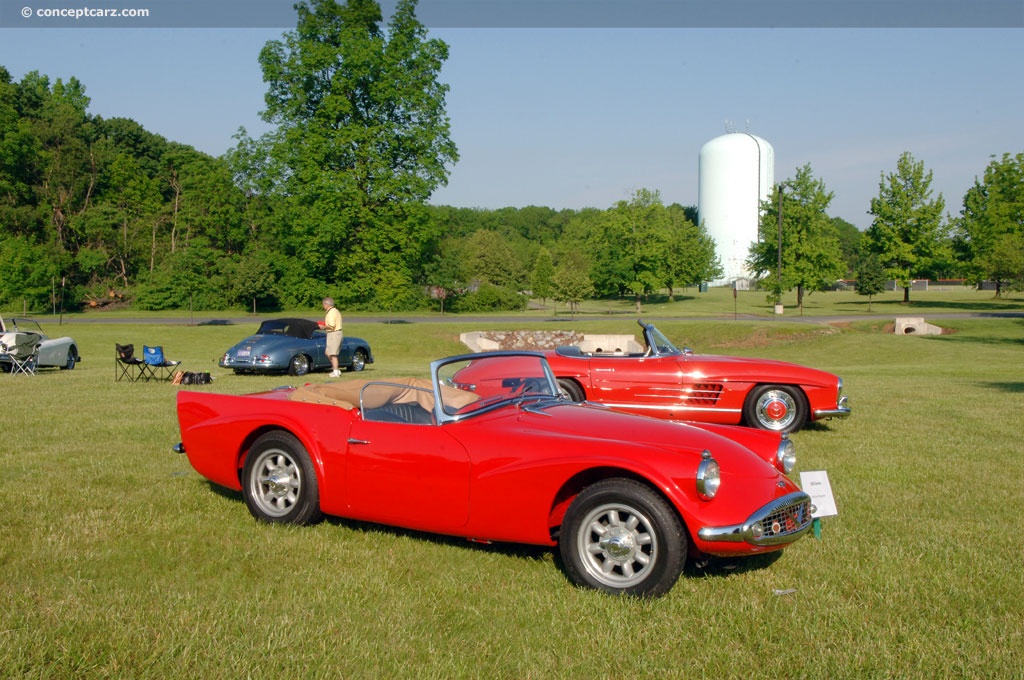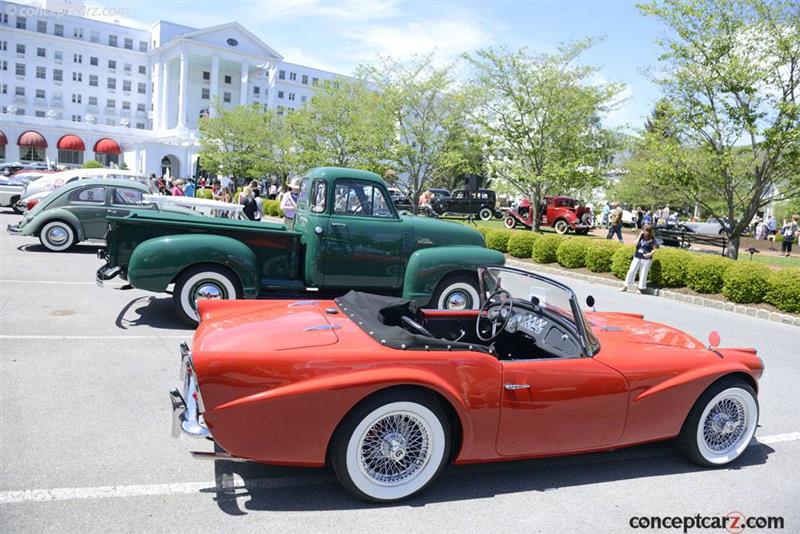The SP250 was the last model to be introduced by Daimler prior to its parent company, the Birmingham Small Arms Company (BSA), was sold to Jaguar Cars in 1960. Daimler was struggling financially during the mid-1950s and the SP250 was intended to breathe new life into the company. It was conceived as a mass-produced sports car designed by a motorcycle designer named Edward Turner. He designed the Hemi-head Daimler 2.5 and 4.5-liter V8 engines by the close of the 1950s. The engine drawings were finalized by March 1958. The 2.5-liter version powered the SP250, and the larger 4.5-liter version was used in the Majestic Major. Although Turner's experience was with Triumph motorcycles, the valve gear of the new Hemi-head V8 engine was more similar to the Chrysler Hemi than the Triumph. The SP250's engine was later installed in the badge-engineered Jaguar MKII that became known as the Daimler V8 250.The chassis was initially a 14-gauge ladder frame with cruciform bracing based on the Triumph TR3. The engine was backed by a Standard manual gearbox used in the Triumph TR3A. It was clothed with fiberglass bodywork, and bumpers were offered as optional equipment. This version, later dubbed the A-spec, was found to lack proper structural rigidity and due to flexing, doors occasionally would come open. Several of the early design features of the A-spec SP250 were later dropped, including the recesses behind the door handles, and the two short, chromium-plated 'whiskers' on both sides of the front grille. The eight-cylinder engine had overhead valves, a cast-iron block, aluminum alloy hemispherical cylinder heads, and a single central camshaft operating valve through short pushrods with double heavy-duty valve springs. It had a five-main bearing crankshaft, SU electric fuel pump, twin SU carburetors, an 8.2:1 compression ratio, and produced 140 horsepower at 5,800 RPM. The four-speed transmission had synchromesh on the top three ratios. An automatic gearbox was optional. The steering was by Cam & follower and the braking was by four-wheel, hydraulically operated, Girling disc brakes. The front independent suspension used coil springs, while the rear used a live axle with half-elliptic leaf springs.The SP250 was described as a 2+2, but the rear bench-like seat provided very little legroom for rear occupants. It was introduced in April of 1959 at the New York Motor Show as the Daimler Dart. The design was not well received and was unofficially voted the ugliest car at the show. Since Dodge owned the trademark for the 'Dart' model name, Daimler was ordered to change the name or succumb to legal action. So the company reverted back to the project number, SP250.The Daimler SP250 (Dart) was in production from 1959 through 1964, falling within the time frame of Daimler's acquisition by Jaguar in 1960. Initial projections predicted that approximately 3,000 examples would be produced per year, but actual production fell far short of that estimate, with just 2,654 examples during its entire production lifespan. This includes the approximately twenty-six (as many as thirty) black examples that were used by the British Metropolitan Police in London. These police vehicles were equipped with the Borg-Warner Model 8 three-speed automatic. Approximately forty percent of all SP250 vehicles produced were sent to the lucrative North American market, including Canada. Many of the remaining cars were sent to the United Kingdom, New Zealand, and Australia. Due to the chassis flex, the A-Spec version was quickly replaced by the subsequently named 'B-Spec', which used extra outriggers on the chassis and a strengthening hoop between the A-posts to add the necessary chassis strength. The B-Spec also had an adjustable steering column and was devoid of the 'whiskers' found on the A-spec. 
RoadsterThe final version was introduced in April of 1963 and is known as the C-spec, bringing with it a heater/demister unit, a cigarette lighter, and a trickle charger socket. The SP250 was affordably priced, offered rather impressive performance and luxury, and an occasional rear seat. The interior had two conventional bucket seats with a full-width rear seat. The roll-up windows were a luxury not found on many of its competitors. The convertible soft top was most successfully (and easily) lowered and raised by two individuals, and could be stowed when not in use. The leather-padded instrument panel housed a speedometer, rev counter, ammeter, water temperature, oil pressure, and fuel gauge. There is a row of switches to operate the wipers, lights, ignition, and choke. Zero-to-sixty mph took 8.9 seconds, and top speed was achieved at nearly 124 mph. Fuel consumption was respectable at around 25 miles per gallon.Designed from scratch, the V8-powered SP250 was the final all-new car from the Daimler Company of Coventry, England - a company that can trace its origins to the late 1890s.
by Daniel Vaughan | May 2021

Roadster
by Daniel Vaughan | May 2021
Related Reading : Daimler 250 History
The last Daimler car to feature a Daimler engine, the Daimler 250 was produced in Coventry, England in 1963. The original Dart was introduced in 1959 at the New York Motor show. At first, it was remarkably popular with a fiberglass body, 2.5-liter Hemi-head V8 and four-wheel Girling disc brakes. After being threatened with legal repercussions by Chryslers Dodge division, the Dart name was dropped....
Continue Reading >>
Continue Reading >>
Similar Automakers
Similarly Sized Vehicles
from 1962
Similarly Priced Vehicles
1962 Daimler SP 250 Vehicle Profiles
Recent Vehicle Additions
Performance and Specification Comparison
Price Comparison
250 Specification Comparison by Year
Year
Production
Wheelbase
Engine
Prices
Related Automotive News

Andy Warhol's exclusive 'Cars' series now open at the Petersen Automotive Museum
The Pop art icons unique Cars series of automotive art and the exceptionally rare Mercedes-Benz vehicles that were its subjects appear in public in the US for the first time in over three decades
Appearing for the first time in North America...

Andy Warhol's 'Cars' series to go on display for the first time in North America in over 30 years at the Petersen Automotive Museum
The Pop art icons unique Cars series of automotive art and the exceptionally rare Mercedes-Benz vehicles that were its subjects appear in public in the US for the first time in over three decades
Appearing for the first time in North America...

15 Exciting Collector Automobiles to Watch During This January's Scottsdale, Arizona Car Week Auctions
Scottsdale, Arizona (January 13th, 2016) – Astute Collectors of the worlds most sought after and most valuable automobiles know that Scottsdale, Arizona in January is where the market values for collector cars are established each year. As such, they...

1964 Nurburgring 1000 Kilometers: Survive for One Last Victory
During the late 1950s, Richie Ginther would begin a relationship with John von Neumann and this partnership would result in one of the most dominant periods of American sportscar racing in which Ginther and Porsche would be virtually unbeatable. Nearly...

RICHARD PETTY DEDICATES MUSCLE CARS FOREVER STAMPS
Raw power gets a stamp of its own today as seven-time NASCAR National Champion Richard Petty helps dedicate the America on the Move Muscle Cars Forever stamps.
Petty, his son Kyle and Postmaster General Patrick Donahoe will dedicate the limited-edition...

































